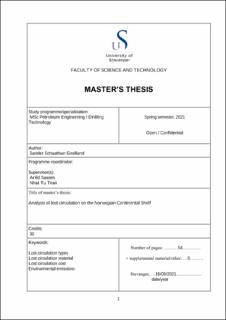| dc.description.abstract | Lost circulation (downhole losses of drilling fluid) is defined by the absence or reduction
of drilling fluid pumped through the drill string while drilling the wells, which filtrates the
formation instead of flowing up to the surface. The Lost circulation is a costly and challenging
problem for the industry, and an extensive amount of money is used to prevent and mitigate
this. Lost circulation can occur at any formation drilled and any well sections where a pressure
imbalance is present, and the formation breakdown pressure is less than the total hydrostatic
pressure in the well.
There are different strategies and methods used in the Oil and Gas industry to prevent lost
circulation. Lost Circulation Material (LCM) is used as a wellbore strengthening strategy to
prevent and cure downhole losses. The LCM treatment is either a remedial or a preventative
treatment and can be added continuously into the wellbore or be spotted as a concentrated LCM
pill.
Environmental emission considerations are closely monitored and crucial if the Oil and
Gas industry shall be up and running in the years to come. Lost circulation issues contribute to
a higher environmental discharge.
This thesis aims to investigate the LCM methods used and their cost, the cost of lost
circulation and environmental impact caused by lost circulation. This was studied by analyzing
different final well reports from different operators. In addition, drilling professionals have been
interviewed to get further insight and information. Where severe downhole losses had occurred,
the wells were in-depth analyzed to find the cost of total drilling fluid lost, LCM used,
environmental discharge, and NPT due to lost circulation.
The analysis' main findings indicated that graphite and CaCO3 as an LCM were used, in
combination or alone, in 74% of the wells where severe losses had occurred. Furthermore, the
cost of NPT in wells with severe downhole losses was, in average, 50 times larger than the
average LCM cost. The average cost of LCM used approximately equaled the cost of one hour
of NPT. Finally, a standardized LCM testing, reporting, and decision flow chart is strongly
recommended to easier draw suitable conclusions. This will give a good basis for further
development. | |
